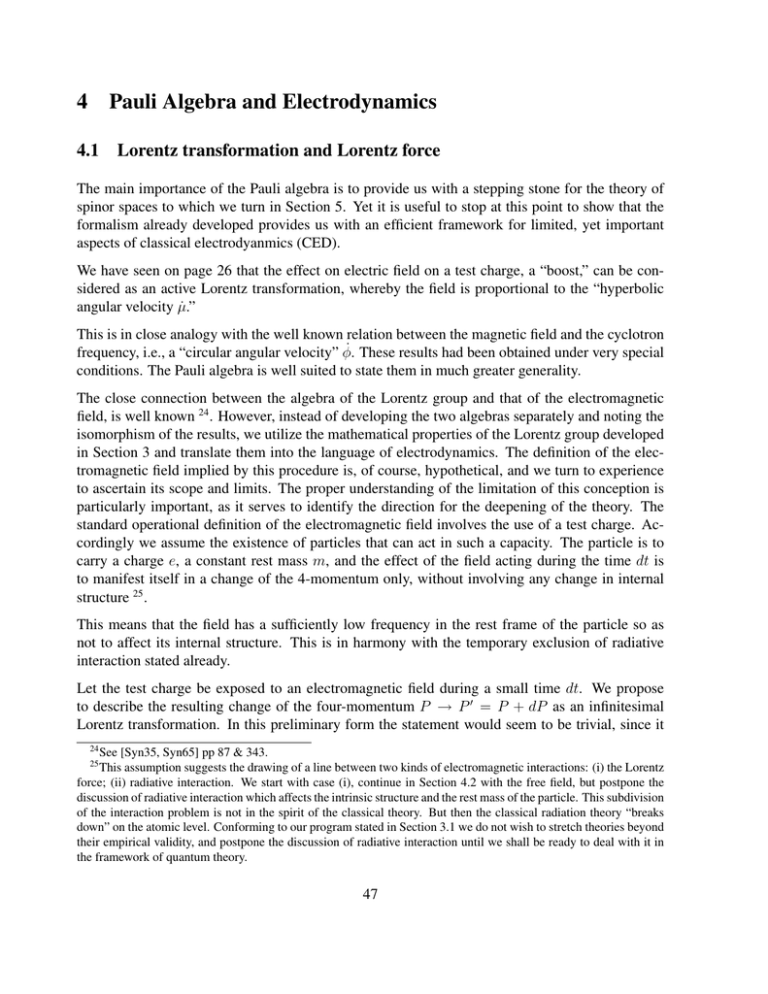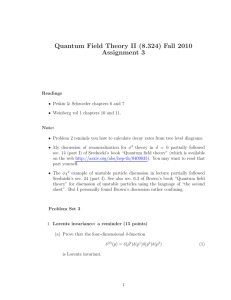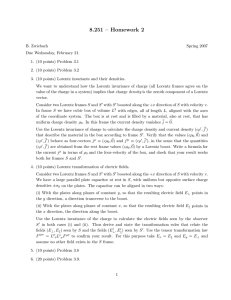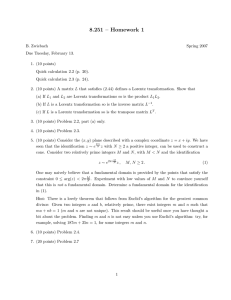4 Pauli Algebra and Electrodynamics
advertisement

4
Pauli Algebra and Electrodynamics
4.1
Lorentz transformation and Lorentz force
The main importance of the Pauli algebra is to provide us with a stepping stone for the theory of
spinor spaces to which we turn in Section 5. Yet it is useful to stop at this point to show that the
formalism already developed provides us with an efficient framework for limited, yet important
aspects of classical electrodyanmics (CED).
We have seen on page 26 that the effect on electric field on a test charge, a “boost,” can be con­
sidered as an active Lorentz transformation, whereby the field is proportional to the “hyperbolic
angular velocity µ̇.”
This is in close analogy with the well known relation between the magnetic field and the cyclotron
frequency, i.e., a “circular angular velocity” φ̇. These results had been obtained under very special
conditions. The Pauli algebra is well suited to state them in much greater generality.
The close connection between the algebra of the Lorentz group and that of the electromagnetic
field, is well known 24 . However, instead of developing the two algebras separately and noting the
isomorphism of the results, we utilize the mathematical properties of the Lorentz group developed
in Section 3 and translate them into the language of electrodynamics. The definition of the elec­
tromagnetic field implied by this procedure is, of course, hypothetical, and we turn to experience
to ascertain its scope and limits. The proper understanding of the limitation of this conception is
particularly important, as it serves to identify the direction for the deepening of the theory. The
standard operational definition of the electromagnetic field involves the use of a test charge. Ac­
cordingly we assume the existence of particles that can act in such a capacity. The particle is to
carry a charge e, a constant rest mass m, and the effect of the field acting during the time dt is
to manifest itself in a change of the 4-momentum only, without involving any change in internal
structure 25 .
This means that the field has a sufficiently low frequency in the rest frame of the particle so as
not to affect its internal structure. This is in harmony with the temporary exclusion of radiative
interaction stated already.
Let the test charge be exposed to an electromagnetic field during a small time dt. We propose
to describe the resulting change of the four-momentum P → P � = P + dP as an infinitesimal
Lorentz transformation. In this preliminary form the statement would seem to be trivial, since it
24
See [Syn35, Syn65] pp 87 & 343.
This assumption suggests the drawing of a line between two kinds of electromagnetic interactions: (i) the Lorentz
force; (ii) radiative interaction. We start with case (i), continue in Section 4.2 with the free field, but postpone the
discussion of radiative interaction which affects the intrinsic structure and the rest mass of the particle. This subdivision
of the interaction problem is not in the spirit of the classical theory. But then the classical radiation theory “breaks
down” on the atomic level. Conforming to our program stated in Section 3.1 we do not wish to stretch theories beyond
their empirical validity, and postpone the discussion of radiative interaction until we shall be ready to deal with it in
the framework of quantum theory.
25
47
is valid for any force that does not affect the intrinsic structure, say a combination of gravitational
and frictional forces. In order to characterize specifically the Lorentz force, we have to add that the
characterization of the field is independent of the fourmomentum of the test charge, moreover it is
independent of the frame of reference of the observer. These conditions can be expressed formally
in the following.
Postulate 1. The effect of the Lorentz force on a particle (test charge) is represented as the trans­
formation of the four-momentum space of the particle unto itself, and the transformations are el­
ements of the active Lorentz group. Moreover, matrix representations in different Lorentz frames
are connected by similarity transformations. (See Section 3.4.4.)
We now proceed to show that this postulate implies the known properties of the Lorentz force.
First, we show that an infinitesimal Lorentz transformation indeed reduces to the Lorentz force
provided we establish a “dictionary” between the parameters of the transformation and the electro­
magnetic field (see below Equation 4.1.12). Consider a pure Lorentz transformation along ĥ
p� = p cosh µ + p0 sinh µ
p�0 = p sinh µ + p0 cosh µ
(4.1.1)
(4.1.2)
where p� = pĥ + p� with p� · �h = 0. For infinitesimal transformations µ → dµ:
p� − p = p0 dµ
p�0 − p0 = pdµ
(4.1.3)
(4.1.4)
˙ = p0 µ̇ĥ
�p
ṗ0 = p� · ĥµ̇
(4.1.5)
(4.1.6)
p� = mc sinh µ = γm�v
p0 = mc cosh µ = γmc
(4.1.7)
˙ = pmcĥµ̇
�p
�v
ṗ0 = pm · ĥµ̇
c
(4.1.8)
or
By making use of
we obtain
Turning to rotation we have from Equation A.3.8 of Appendix A (See note on page 51 ).
p��⊥ = p�⊥ cos φ + uˆ × p�⊥ sin φ
48
(4.1.9)
For an infinitesimal rotation φ � dφ, and by using Equation 4.1.7 we obtain, since p��� = p�� and
p�� × û = 0,
p�� − p� = −�p × uˆ dφ = −γm�v × uˆ dφ
(4.1.10)
or,
˙ = −γm�v × uˆ dφ
�p
(4.1.11)
With the definitions of 3.3.28 and 3.3.29 of page 26 written vectorially:
� = γmc µ̇ĥ
E
e
−γmc
� =
B
φ̇û
e
(4.1.12)
Equations 4.1.8 and 4.1.9 reduce to the Lorentz force equations.
Let us consider now an infinitesimal Lorentz transformation generated by
V
µ
iφ
ĥ · �σ − û · �σ
2
2
�
edt � �
� · �σ
= 1+
E + iB
2γmc
edt
= 1+
F
2γmc
= 1+
(4.1.13)
(4.1.14)
(4.1.15)
with
� + iB,
�
f� = E
F = f� · �σ
(4.1.16)
It is apparent from Equations 4.1.15 and 4.1.16 that the transformation properties of V and F are
identical. Since the transformation of V has been obtained already in Section 3.4.4, we can write
down at once that of the field f�.
Let us express the passive Lorentz transformation of the four-momentum P from the inertial frame
Σ to Σ� as
P � = SP S †
(4.1.17)
where S is unimodular. The field matrix transforms by a similarity transformation:
F � = SF S −1
(4.1.18)
with the complex reflections (contragradient entities) transforming as
For
P̄ � = S̄P̄ S̄ −1
F̄ � = S̄F̄ S̄ †
(4.1.19)
(4.1.20)
µ
S = H = exp(− ĥ · �σ )
2
(4.1.21)
49
we obtain the passive Lorentz transformation for a frame Σ2 moving with respect to Σ1 , with-the
velocity
�v = cĥ tanh µ
F � = HF H −1
We extract from here the standard expressions by using the familiar decomposition
f� = f�� + f�⊥ = (f� · ĥ)ĥ
(4.1.22)
(4.1.23)
(4.1.24)
we get
f��� = f��
(4.1.25)
�
�
�
�
−1
2 �
�
�
f⊥ · �σ = H f⊥ · �σ H = H f⊥ · �σ
�
�
= cosh µ − sinh µĥ · �σ f�⊥ · �σ
(4.1.26)
(4.1.27)
Hence
f�⊥� = f�⊥ cosh µ + i sinh µ ĥ × f�⊥
�
�
�
�
= cosh µ f⊥ + i tanh µ ĥ × f⊥
�
�
�v �
�
= γ f⊥ + i × f⊥
c
where we used Equation 4.1.22. Inserting from Equation 4.1.16 we get
�
�
�
v
�
�⊥
�⊥ = γ E
�⊥ + × B
E
c
�
�
�
v
�
�
�
�⊥
B
×E
⊥ = γ B⊥ −
c
�� = E
� �,
�� = B
��
E
B
�
(4.1.28)
(4.1.29)
(4.1.30)
(4.1.31)
�
It is interesting to compare the two compact forms 4.1.18 and 4.1.31. Whereas the latter may be
the most convenient for solving specific problems, the former will be the best stepping stone for
the deepening of the theory. The only Lorentz invariant of the field is the determinant, which we
write for convenience with the negative sign:
1
�2 − B
� 2 + 2iE
� ·B
� = g 2 e2 Ψ
−|F | = T rF 2 = f�2 = E
(4.1.32)
2
Hence we obtain the well know invariants
�2 − B
� 2 = g 2 cos 2ψ
I1 = E
(4.1.33)
2
� ·B
� = g sin 2ψ
I2 = 2E
We distinguish two cases
50
1. f�2 �= 0
2. f�2 = 0
These cases can be associated with the similarity classes of Table 3.2. In the case (i) F is uni­
modular axial, for (ii) it is nonaxial singular. (Since F is traceless, the two other entries in the
table do not apply.) We first dispose of case (ii). A field having this Lorentz invariant property is
called a null-field. The F matrix generates an exceptional Lorentz transformation (Section 3.4.4).
� and B
� are perpendicular and are of equal size. This is a relativistically
In this field configuration E
invariant property that is characteriestic of plane waves to be discussed in Section 4.2.
In the “normal” case (i) it is possible to find a canonical Lorentz frame, in which the electric and
the magnetic fields are along the same line, they are parallel, or antiparallel. The Lorentz screw
corresponds to a Maxwell wrench26 . It is specified by a unit vector ŝn and the values of the fields
in the canonical frame Ecan and Bcan . The wrench may degenerate can can with Ecan = 0, or
Bcan = 0. The canonical frame is not unique, since a Lorentz transformation along n̂ leaves the
canonical fields invariant.
We can evaluate the invariant eqn:iii-8-18ab in the canonical frame and obtain
2
2
Ecan
− Bcan
= I1 = g 2 cos 2ψ
2Ecan Bcan = I2 = g 2 sin 2ψ
(4.1.34)
(4.1.35)
Ecan = g cos ψ
Bcan = g sin ψ
(4.1.36)
(4.1.37)
One obtains from here
The invariant character of the field is determined by the ratio
Bcan
= tan ψ
Ecan
(4.1.38)
that has been called its pitch by Synge (op. cit. p. 333) who discussed the problem of canonical
frames of the electromagnetic field with the standard tensorial method.
The definition of pitch in problem #8 is the reciprocal to the one here given and should be changed
to agree with Eq. (20)
NOTE: Eq. (18) of Appendix A is incorrect. Eq. (6) is identical
to the unnumbered equation preceding (18).
26
See Synge, as quoted on page 47.
51
4.2
The Free Maxwell Field
Our apporach to CED thus far is unusual inasmuch as we have effectively defined, classifed and
transformed the electromagnetic field at a small region of space-time without having used the
Maxwell equations. This is, of course, an indication of the effectiveness of our definition of the
field in terms of active Lorentz transformations.
In order to arrive at the Maxwell equations we invoke the standard principle of relativistic invari­
ance, involving the passive interpretation of the Lorentz group.
Postulate 2. The electromagnetic field satisfies a first order differential equation in the space-time
coordinates that is covariant under Lorentz transformations.
We consider the four-dimensional del operator {∂0 , �} with ∂0 = ∂/∂(ct) = ∂/∂r0 as a fourvector, with its matrix equivalent
D = ∂0 − � · �σ
(4.2.1)
The rationale for the minus sign is as follows. Let D operate on a function representing a plane
wave:
ψ = exp −i(ωt − �k · �r) = exp −i(k0 r0 − �k · �r)
(4.2.2)
we have
�
�
iDψ = k0 1 + �k · �σ ψ = Kψ
(4.2.3)
Thus D has the same transformation properties as K:
D� = SDS †
(4.2.4)
D̄ = ∂0 1 + � · �σ
(4.2.5)
¯ −1
¯ � = S̄ DS
D
(4.2.6)
while the complex reflection
transforms as K̄, i.e.
¯ transforms as a
By using the transformation rules 4.1.18, 4.1.20 of the last section we see that DF
four-vector J:
�
��
�
¯ −1 SF S −1 = S̄ JS
¯ −1
S̄ DS
(4.2.7)
Thus
¯ = J¯
DF
(4.2.8)
is a differential equation satisfying the conditions of Postulate 2. Setting tentatively
J = ρ1 +
52
�j
· �σ
c
(4.2.9)
with ρ, �j the densities of charge and current, 4.2.8 is indeed a compact form of the Maxwell equa­
tions.
This is easily verified by sorting out the terms with the factors (1, σk ) and by separating the real
and imaginary parts.
By operating on the Equation 4.2.9 with D and taking the trace we obtain
and
¯ = (∂02 − �2 )F = DJ¯
DDF
(4.2.10)
1
1� �
·j =0
T rDJ¯ = ∂0 ρ + �
2
c
(4.2.11)
These are standard results which are easily provided by the formalism. However, we do not have
an explicit expression for J that would be satisfactory for a theory of radiative interaction.
Therefore, in accordance with our program stated in Section 4.1 we set J = 0 and examine only
the free field that obeys the homogeneous equations
D̄F = 0
(4.2.12)
� 2
�
∂0 − �2 F = 0
The simplest elementary solution of 4.2.12 are monochromatic plane waves from which more
complicated solutions can be built up. Hence we consider
�
�
�
�
F (�r, t) = F+ (�k, ω) exp i(ωt − �k · �r) + F− (�k, ω) exp i(ωt − �k · �r)
(4.2.13)
where F± are matrices independent of space-time. Inserting into Equation 4.2.12 yields the condi­
tion
ω 2 − c2 k 2 = 0
(4.2.14)
Introducing the notation
θ = k0 r0 − �k · �r
(4.2.15)
F (�r, t) = F+ exp(−iθ) + F− exp(iθ)
(4.2.16)
�
�
� ± + iB
� ± · �σ = 0
KF± = K E
(4.2.17)
we write Equation 4.2.13 as
Inserting into 4.2.12 we have
53
From here we get explicitly
�
�
�k · E
� ± + iB
�± = 0
�
�
ˆ E
� ± + iB
� ± + iB
� ± = ikx
�±
E
(4.2.18)
(4.2.19)
� and B
� are of equal magnitude, and
and we infer the well known properties of plane waves: E
� B,
� �k from a right-handed Cartesian triad. We note that this constellation corresponds to the
E,
field of the type (ii) with f�2 = 0 mentioned on page 51.
�, B
� are real, we have also the relations
Since the classical E
�− = E
�∗,
E
+
�− = B
�∗
B
+
(4.2.20)
Consider now the case in which
� − + iB
�− = 0
f�− = E
(4.2.21)
� + = iB
�+
E
(4.2.22)
which, in view of 4.2.20 implies
Thus at a fixed point and direction in space the electric field lags the magnetic field by a phase
� + + iB
� + ) is the amplitude of a circularly polarized wave of positive helicity,
π/2, and f�+ = (E
i.e., the rotation of the electric and magnetic vectors and the wave vector �k form a right screw
or the linear and angular momentum point in the same direction +�k. In the traditional optical
terminology this is called a left circularly polarized wave. However, following current practice, we
shall refer to positive helicity as right polarization R. The negative helicity state is represented by
� − + iB
� − ).
f�− = (E
� − − iB
� − ) with R and f�+∗ = (E
� + − iB
� +)
Actually, we have the alternative of associating f�−∗ = (E
with L. However, we prefer the first choice and will use the added freedom in the formalism to
describe the absorption and the emission process at a later stage 27
Meanwhile, we turn to the discussion of polarization which has a number of interesting aspects,
particularly if carried out in the context of spinor algebra.
27
In the literature the Fourier decomposition of the field is usually written in terms of the vector potential rather
� + iB
� . The latter method, which alone leads naturally to a decomposition into helicity states, is
than in terms of E
considered by [Kra58], see page 86.
54





